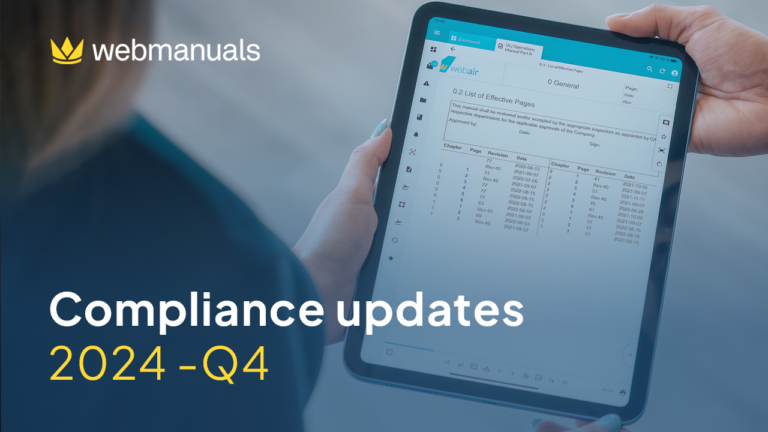As a flight director, compliance manager, or quality assurance specialist, getting aviation management to invest in software, especially those related to documents and manuals, can be challenging at times. Yet, to have streamlined processes and structured documentation is one of the most fundamental components in successful flight operations.
Web Manuals sat down with Alexander Kruschat, from DC Aviation in Germany, to discuss how to encourage software investments to aviation management.
Alexander has worked at DC Aviation’s quality department for 5 years focusing on auditor safety and compliance management. Operations include 17 different types of aircraft and AOCs in countries such as Dubai and Malta.
Since Alexander encouraged DC Aviation’s senior management to adopt Web Manuals, all operational documents have been centralized to one location and control has been approved significantly.
“We all just got to get used to working with these tools and to not be afraid of our manuals”, Alexander argues.

1. Focus on Your Needs
Before you identify pros and cons of the software, understand your needs. Identify where the company is situated with compliance, manuals and documentation currently and where the company aspires to be in the future.
What is working and what is not working? Which documents need improvements and in what areas? Where do you have to start?
Alexander emphasizes, “find out exactly what you need first and then evaluate the software given on the market”.
2. Research the Software
Identify all pros and cons of the software. It is important to understand what the software will and will not solve to provide an accurate picture to management. Overpromising management as a result of premature optimism will harm you when it comes to these types of investments. Make sure to do your research properly with great emphasis on details before presenting it further to upper management.
Web Manuals is transparent on the website and has a good overview of functions and capabilities, including:
- A page with all features, over 100 features are explained in detail
- Detailed user guides of specific processes in the system
- Video tutorials where you can see specific areas of the system
- Webinars such as a full 60-minute demo of the system, EFB benefits and the challenge of staying compliant
These resources can be favorably used when presenting to upper management. And remember, don’t be afraid to contact us at Web Manuals for help to make the case for all stakeholders in your company.
3. Compare to Your Current Way of Working
Alex continues to explain, most operators use Word today so when discussing Web Manuals he often focuses on the positive aspects of using a document management system over a document editor. MS Office is a great platform in many ways, but it is not made for aviation and hundreds of pages long manuals.
If you already use a compliance software, it is even more important to compare the different ways of working. Many of these include distribution services but lack features such as authoring and compliance linking. Make sure to list your current way of working, next to the new way of working, to clearly showcase the impact of changing ways.
4. Be Upfront About Pricing
Next, it is important to be honest and straightforward when it comes to pricing. Make sure to be clear with what features of the system you need so the pricing is correct from the start. At the same time, try to limit pricing to include only what you need. That makes it easier for management to say yes to the investment when the pricing is presented together with the limitations and the customized solution.
One of the pros of Web Manuals is its flexible pricing. Alexander highlights that “WM is ideal for mid-size operators. Flexibility in pricing structure is important for mid-size operators”. Many compliance software have fixed pricing where most don’t take into account the size of the operations or the number of users.
5. Encourage the Change
In the end, it is important to get both aviation management and team members to see the long-term results over the short-term pain. Getting management to invest in non-operational aviation software might seem off-putting at first, but it is fundamental to the continuous improvement and future growth of the business. Getting aviation management to think beyond safety and see the benefits of the management system is key.
“On the first hand, it may seem that implementing Web Manuals into a company can be a huge load of work. Therefore a structured plan is necessary and it is important to tell people that time does not matter and that people can take up to a year or more to implement their documents. A clear structure and plan should be made as a guideline for the company”.
“Make powerpoints when presenting the change. Identify expectations, present solutions, and discuss pros and cons of each alternative. Be positive, realistic, and motivating – all at once. Visualize and convince by showing specific examples, numbers, and solutions.”
Considering the nature of the work, it is important to motivate people to keep the wheel spinning and to get a certain amount of people together that familiarize themselves with the software as quickly as possible. The faster people engage with the software, the quicker the knowledge sharing and the earlier you revel in the benefits.

Please contact us if you have any further questions about how to encourage software investments to aviation management or need support in convincing stakeholders.




